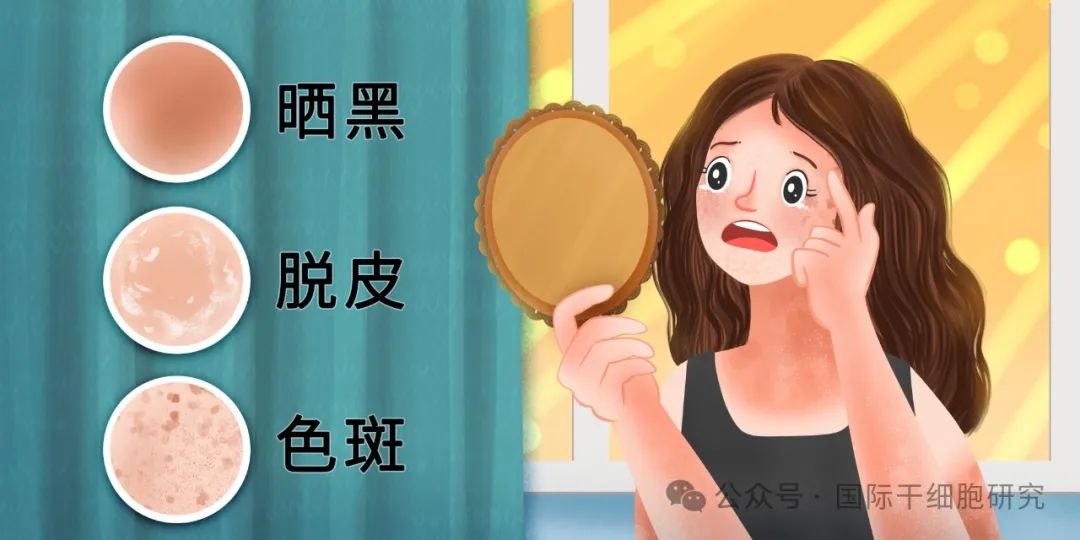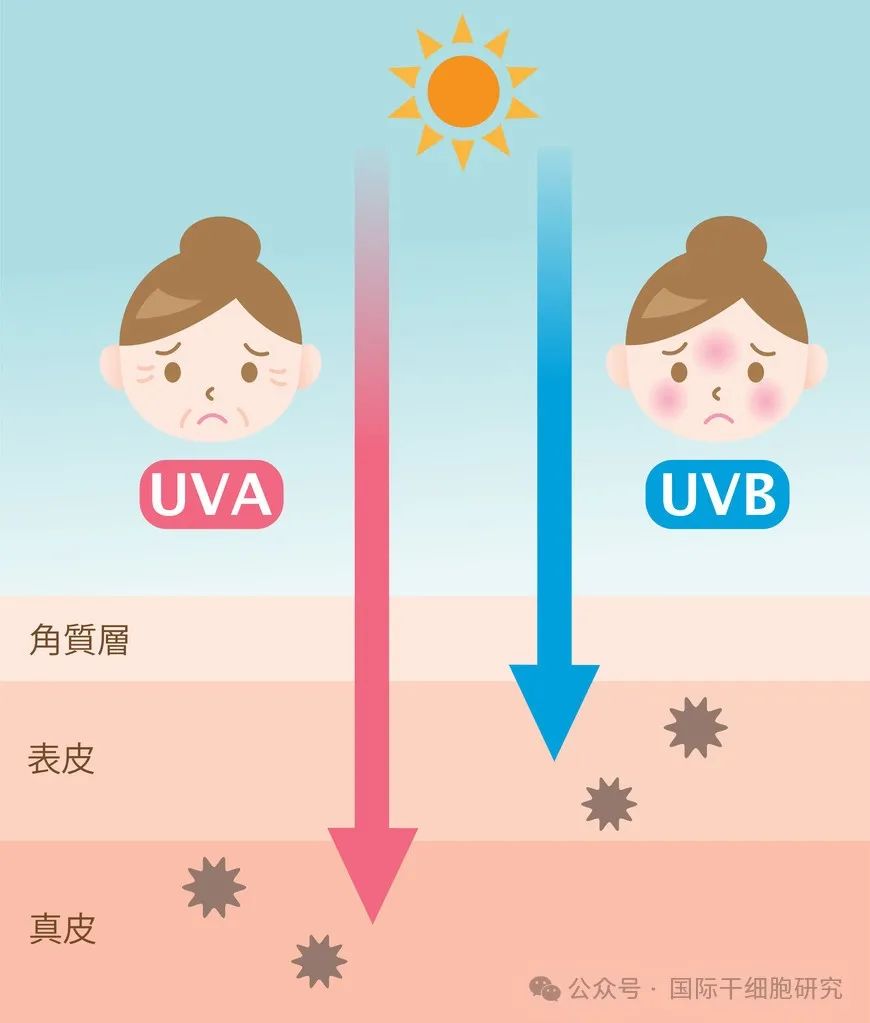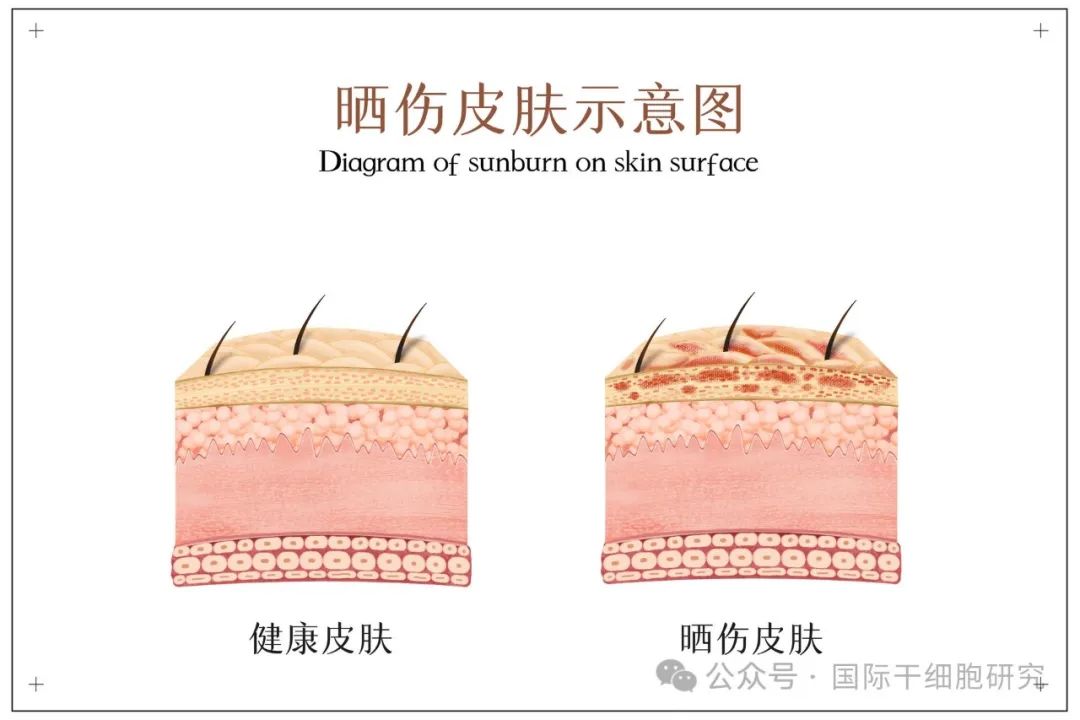
Source: International Stem Cell Research
Maintaining youth and beauty is an eternal topic pursued by countless people, but the skin is a complex organ, in addition to age, long-term ultraviolet (UV) exposure is also one of the important factors leading to skin aging, accounting for about 80% of facial aging factors.
In recent years, with the deepening of research on stem cells and their derivative products, stem cells and exosomes have received extensive attention in the field of anti-aging medicine and aesthetic medicine, in order to meet the growing desire of beauty lovers to maintain young and healthy skin.
What is photoaging?

Photoaging of skin is caused by long-term exposure to ultraviolet radiation, resulting in a variety of skin damage, such as telangiectasia, pigmentation, skin dryness, wrinkle formation and so on.
An important histological feature of skin photoaging is the accumulation of amorphous elastic fibers, accompanied by the destruction and disorder of collagen, resulting in skin roughness, relaxation, wrinkles and other photoaging manifestations.
In addition, skin appendages also undergo significant changes during photoaging, such as atrophy of sebaceous glands, reduced sweating, and insufficient secretion of surface emulsions. Keratinocyte activity is reduced, renewal is slowed, and the epidermal barrier is weakened, resulting in dryness and desquamation of the skin.
At the same time, the number of dermal fibroblasts decreased, collagen and elastin synthesis slowed down, and decomposition accelerated. It can also be accompanied by a decrease in Langerhans cells, resulting in decreased immunity.
The culprit of skin photoaging

Skin photoaging is mainly caused by ultraviolet radiation. There are three kinds of ultraviolet radiation in sunlight, namely UVA (wavelength of 320~400nm), UVB (wavelength of 280~320nm), and UVC (wavelength of 200~280nm). Because UVC is mostly blocked by the ozone layer, the main culprits of skin photoaging are UVA and UVB.
1、UVB
Acute UVB exposure reduces dermal and epidermal hyaluronic acid (HA) levels, a significant change seen in aging skin. The effects of UVB on the dermis involve soluble mediators derived from keratinocytes, as well as matrix metalloproteinases (MMP) that affect the extracellular matrix (ECM).
2、UVA
UVA is a long wave ultraviolet light that penetrates deep into the dermis and directly affects dermal fibroblasts. Long wave UVA1 radiation can cause macromolecular damage and mitochondrial DNA deletion in dermal fibroblasts.
Why can mesenchymal stem cells resist photoaging?
Studies over the past few decades have shown that mesenchymal stem cells (MSC) can enhance skin regeneration by regulating inflammatory response, promoting cell proliferation and migration, inhibiting cell apoptosis, promoting good tissue formation of blood vessels, etc., and use them to combat skin photoaging, mainly due to the following mechanisms:
1、antioxidant
Studies have shown that UV radiation can lead to excessive production of ROS, resulting in increased production of malondialdehyde (MDA), while MSC, represented by Japanese adipose-derived stem cells, can inhibit the production of MDA and reduce the adverse effects of UV radiation on skin. At the same time, it can also restore the activity of superoxide dismutase (SOD), so as to remove overgenerated oxygen free radicals, prevent cell damage, and provide a strong basis for improving skin photoaging.
2、Inhibit cell apoptosis and combat DNA damage
Studies have shown that Japanese adipose-derived stem cells can secrete a large number of cytokines, but also transport and regulate proteins, so as to inhibit UVB induced apoptosis, and ultimately achieve the purpose of improving skin photoaging.
3、Promote the proliferation and migration of fibroblasts
Studies have shown that MSC can secrete cytokines and growth factors, which can not only promote the proliferation and migration of dermal fibroblasts, but also stimulate collagen synthesis, thereby improving skin photoaging.
4、Inhibit inflammation
Studies have shown that Japanese adipose-derived stem cells can also inhibit the early migration of white blood cells by down-regulating leukotrienes and other chemokines, thereby improving inflammation and immune response, and ultimately reversing skin photoaging.
How do exosomes combat skin photoaging?

Mesenchymal stem cell (MSC) -derived exosomes are nanoscale vesicles with an average diameter of about 100nm and contain a variety of substances, such as DNA, miRNA, cytokines, proteins, metabolites, etc. As a cell-free therapy, exosomes have broad application potential in the fight against skin photoaging, mainly through the following mechanisms:
1、Effects of exosomes on epidermal cells
The main components of the epidermis are keratinocytes, which make up about 95% of the epidermal composition, and these keratinocytes protect against toxins and pathogens, regulate heat and water loss, and release cytokines to stimulate inflammation.
Studies have shown that hucMSC-Exos derived from human umbilical cord mesenchymal stem cells, rich in 14-3-3z protein, can up-regulate the expression of SIRT1 in keratinocytes, and SIRT1/Nrf2 signaling pathway is crucial for inhibiting inflammation, reducing oxidative stress, and delaying aging. Finally, it can achieve the purpose of inhibiting the oxidative stress induced by ultraviolet radiation, thereby helping to improve the skin photoaging.
2、Effects of exosomes on ROS
Reactive oxygen species (ROS) are a by-product of cellular metabolism, and UV radiation induces the production of ROS, which disrupts the balance between the skin's oxidative and antioxidant systems and impairs its ability to remove ROS.
High concentrations of ROS can cause oxidative stress damage to DNA, proteins and lipids, and are associated with sunburn, aging, inflammatory diseases, and so on.
Studies have shown that adipose stem cell exosomes (ADSC-Exos) can up-regulate the level of superoxide dismutase (SOD) and down-regulate the level of MDA to counteract galactose-induced skin oxidative stress. At the same time, it can also inhibit the expression of ROS producing enzymes, thereby reducing ROS production, and finally achieve the purpose of improving photoaging.
3、Effects of exosomes on matrix metalloproteinases
Matrix metalloproteinases (MMP) are peptidases found in living organisms that bind metal ions at their active sites. In human skin, UV exposure significantly increases the expression of certain MMPS-such as MMP-1, MMP-2, MMP-3, and MMP-9-which contribute to the degradation of collagen and elastin. Therefore, controlling MMP activity is an effective strategy to improve photoaging.
Studies have shown that adipose stem cell exosomes (ADSC-Exos) can reduce UVB-induced MMP expression and restore the levels of collagen, elastin, tissue inhibitor of matrix metalloproteinase-1 (TIMP-1), transforming growth faction-β1 (TGF-β1) dermal fibroblasts, thereby helping to improve skin photoaging.
4、Effects of exosomes on fibroblasts
Fibroblasts are the major cellular components of the dermis and are responsible for the production of collagen, other ECM components such as fibronectin and elastin, which support tissue strength, elasticity, and fibroblast migration. The impaired fibroblast function and ECM changes are closely related to skin aging.
Studies have found that adipose stem cell exosomes (ADSC-Exos) contain a variety of cytokines (such as IL-1, IL-2, EGF, FGF, etc.), which can promote the recruitment and proliferation of dermal fibroblasts and improve photoaging.
5、Effects of exosomes on melanin
Epidermal melanin units are formed by melanocytes and surrounding keratinocytes, and the skin's long-term exposure to the sun triggers a signaling cascade that stimulates the secretion of hormones and growth factors, ultimately leading to increased melanin synthesis in melanocytes, resulting in pigmentation manifestations such as pigmentation spots.
The study found that keratinocytes communicate with melanocytes through mirNA-carrying exosomes to regulate pigmentation. The function of keratinocyte derived exosomes is affected by phototype and regulated by UVB. Recent studies have confirmed that human keratinocyte derived exosomes have a quantitative effect on human melanocyte activation even in the absence of UVB exposure.
In patients with melasma, downregulation of miR675 stimulates pigmentation, and miR675 is secreted in keratinocyte derived exosomes with MITF as a direct target.
6、Effects of exosomes on inflammation and immunity
Inflammation is a protective response caused by harmful stimuli, which can lead to local skin fever, pain, redness, swelling and other manifestations. Skin inflammation caused by UV radiation promotes immunosuppression by expanding regulatory T cells (TREGs).
Mesenchymal stem cell exosomes promote the polarization of macrophages from the pro-inflammatory M1 phenotype to the anti-inflammatory M2 phenotype. Studies have shown that bone marrow mesenchymal stem cell (BM-MSC) exosomes can promote the proliferation and immunosuppressive ability of Tregs by upregating IL-10 and TGF-β1, thereby inhibiting pro-inflammatory cytokines and ultimately inhibiting skin inflammation.
Human umbilical cord mesenchymal stem cells (hucMSC-Exos) can decrease the expression of proinflammatory cytokines, while increase the expression of anti-inflammatory cytokine IL-10, and finally achieve the purpose of improving skin inflammation and aging。
Small series message
The damage of ultraviolet rays to the skin can not be underestimated, and the differentiation of strong, rich sources of mesenchymal stem cells, is a promising method to combat light aging. In addition, current studies have shown that methods such as hydrogels and microneedle rollers have also shown surprising effects in enhancing MSC exosomes and combating skin photoaging. However, as an emerging therapy, in order to ensure the quality of cells, it is recommended that you choose a regular medical institution.